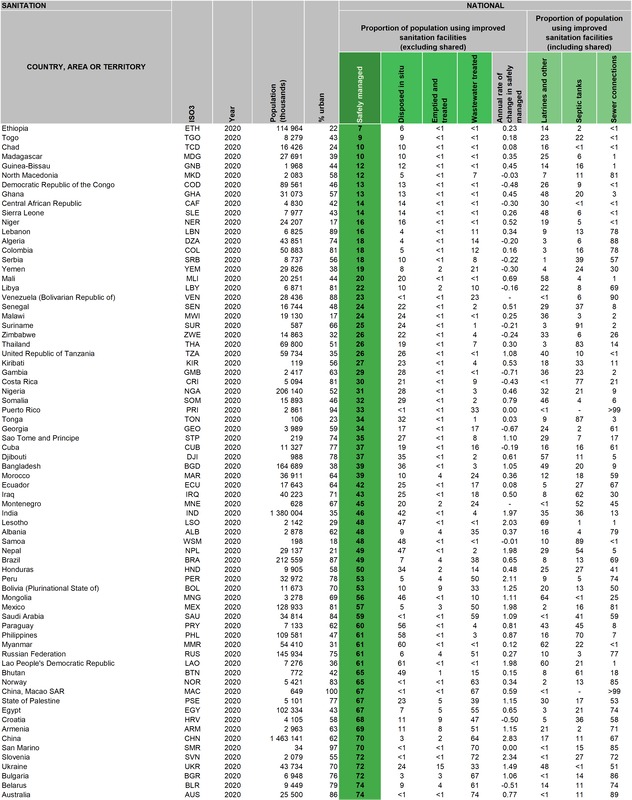Many countries in the drinking water list (Table in blog post 2 of 7) do not appear in the sanitation list (Table 3, below) because of gaps in the national sanitation data. The countries so affected do, however, have national statistics for “latrines and other”, “septic tanks”, and “sewer connections”. For the record, 16 countries were expected to be in both tables but were not (in order of lowest to highest national proportion of safely managed drinking water): Rwanda, Uganda, Afghanistan, Cambodia, Côte d’Ivoire, Pakistan, Congo, Tajikistan, Nicaragua, Guatemala, Wallis and Futuna Islands, Uzbekistan, Democratic People’s Republic of Korea, Kyrgyzstan, Albania, and Republic of Moldova.
Surprisingly, the list in the Sanitation Table below contains some countries that are in the High-income group as defined by their nominal values of Gross National Income (GNI) per capita in 2020‒2021 [>US$12,695; Atlas method— indicator of income developed by the World Bank; Wikipedia: List of countries and dependencies by GNI (nominal) per capita, USD]. These high-income group countries with relatively great household sanitation challenges are: Australia; China, Macao SAR; Croatia; Norway; Saudi Arabia; and Slovenia. Because of their relatively high per capita income status, these countries are good initial marketing targets for versions of AWGs designed to provide clean water for sanitation applications.

(https://blogs.worldbank.org/health/water-and-sanitation-health-why-progress-slow). Their main points help to answer why:
- “Several million people, many of them [children], die from diarrheal diseases every year. Many of these deaths can be attributed to unsafe water, poor sanitation and poor hygiene”;
- Supply factors are “at play” including “lack of infrastructure functionality”, “lack of local responsibility”, water scarcity;
- “[One] should not underestimate the role of culture, tradition, and behaviors”;
- “Adequate sanitation is also essential for health. Yet again, in many low-income countries, only a small minority of households has access to improved sanitation. Part of this may be due to a low priority assigned to sanitation in terms of public funding. But part of it is also due to cultural and traditional norms, as well as lack of income or time. Poor terrain or soil type and a lack of land to build latrines also play a role in some areas”;
- “Focus group participants were asked why they pay for cell phones but not for latrines. They responded that latrines have a much larger one-time cost, but also that having a cell phone is a sign of modernity and important for one’s status in communities. Clearly, more needs to be done to convince households of the importance of latrines, for example through sanitation marketing campaigns”;
- “Finally, in terms of health benefits, there is perhaps no more cost-effective intervention tha[n] the promotion of hand washing, but only a small minority of Uganda’s households (less than one in ten) has a facility to wash hands with both soap and water. Information campaigns are held, but, as a participant in focus groups noted, “many of the community members do not attend them, saying that these trainings are a waste of time”;
- “hand washing is viewed as a very strange practice to the local culture”; and
- “Uganda has invested over the years in safe water and sanitation. But the constraints faced by households and communities are complex. The qualitative work implemented in 14 districts suggests that solutions often must be context- and community-specific.”
I have noted, over many years in the water-from-air field, that academic researchers and businesses are focused almost totally on providing potable water—sanitation gets mentioned rarely, if at all. But clean water is essential for personal hygiene for men, women, children, and infants—using polluted water or not having any water at all for sanitation applications has the potential for causing dreadful health problems. Designing versions of AWGs specifically for personal hygiene could be a competitive advantage that would also improve the quality of life for millions of people.

